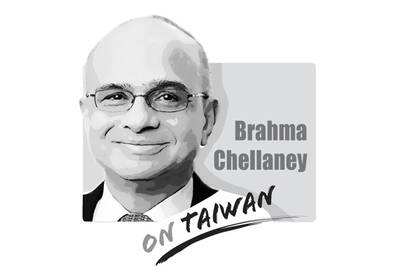Looking back at former president Lee Teng-hui’s (李登輝) “no haste, be patient” policy with regard to Taiwan’s cross-strait economic and trade relations, it was important at the time in terms of risk management and internal government controls. Even today, when dealing with China, Taiwan still cannot overlook the effects that any policy could have on national security, economic independence, the investment environment and social development — a consideration that was included in the “no haste” policy implemented in 1996 during Lee’s 12 years in power.
In the mid to late 1990s, the whole world was focused on the massive investment opportunities in China, and Taiwan was no exception, aiming to grab a sizeable share of the huge Chinese market. However, as opportunities are inevitably accompanied by risks, the government under Lee adopted the “no haste” policy to cap China-bound investments at US$50 million per project, ban the production of high-tech products in China and place restrictions on infrastructure sectors.
The policy received a lot of criticism from several business heavyweights at the time, including Formosa Plastics Group’s late founder, Wang Yung-ching (王永慶), and former Taiwan Semiconductor Manufacturing Co (TSMC) chairman Morris Chang (張忠謀).
The “no haste” policy certainly did not end capital outflows from Taiwan, and it also failed to effectively bar industries from making investments in China through indirect channels or relocating their assets there via a third country. Some political observers might also see it as a superficial measure, but it still set up some key thresholds so that the flow of funds across the Taiwan Strait would not excessively affect Taiwan’s overall economic and social development. In retrospect, the substitution of the “no haste” policy with former president Chen Shui-bian’s (陳水扁) “active opening and effective management” policy in 2001 led to even more investment pouring into China.
This year, the COVID-19 outbreak left China’s economic activities stagnating for three to four months due to factory shutdowns, production suspensions and city lockdowns. As China remains the largest offshore production base for Taiwanese manufacturers, it is difficult to imagine how Taiwan’s economy would fare today if all of the nation’s major industries had relocated and set up factories in China 24 years ago without the restrictions set by the “no haste” policy.
The outbreak has also revealed the deficiencies in the crisis management capabilities of the Chinese government, which proves that a certain level of economic control in specific areas regarding the development of trade relations with China is needed. Regarding cross-strait economic exchanges, it was righ to promote the “no haste” policy two decades ago and remains so today, considering the deteriorating trade relations between the US and China, and Beijing’s geopolitical ambitions.
Whether it is Lee’s “no haste” policy or President Tsai Ing-wen’s (蔡英文) “New Southbound Policy,” people must be reminded not to put all their eggs in the China basket to prevent Taiwan from becoming over-reliant on its giant, unstable neighbor. If there was no “no haste” policy, TSMC and many other semiconductor firms might have invested heavily in China, and Taiwan would have lost its “silicon shield.” In the past, people had different opinions about the necessity of the “no haste” policy, but looking back at it today, more people are feeling differently, including those who criticized it strongly.

China badly misread Japan. It sought to intimidate Tokyo into silence on Taiwan. Instead, it has achieved the opposite by hardening Japanese resolve. By trying to bludgeon a major power like Japan into accepting its “red lines” — above all on Taiwan — China laid bare the raw coercive logic of compellence now driving its foreign policy toward Asian states. From the Taiwan Strait and the East and South China Seas to the Himalayan frontier, Beijing has increasingly relied on economic warfare, diplomatic intimidation and military pressure to bend neighbors to its will. Confident in its growing power, China appeared to believe
Taiwan-India relations appear to have been put on the back burner this year, including on Taiwan’s side. Geopolitical pressures have compelled both countries to recalibrate their priorities, even as their core security challenges remain unchanged. However, what is striking is the visible decline in the attention India once received from Taiwan. The absence of the annual Diwali celebrations for the Indian community and the lack of a commemoration marking the 30-year anniversary of the representative offices, the India Taipei Association and the Taipei Economic and Cultural Center, speak volumes and raise serious questions about whether Taiwan still has a coherent India
Recent media reports have again warned that traditional Chinese medicine pharmacies are disappearing and might vanish altogether within the next 15 years. Yet viewed through the broader lens of social and economic change, the rise and fall — or transformation — of industries is rarely the result of a single factor, nor is it inherently negative. Taiwan itself offers a clear parallel. Once renowned globally for manufacturing, it is now best known for its high-tech industries. Along the way, some businesses successfully transformed, while others disappeared. These shifts, painful as they might be for those directly affected, have not necessarily harmed society
Legislators of the opposition parties, consisting of the Chinese Nationalist Party (KMT) and the Taiwan People’s Party (TPP), on Friday moved to initiate impeachment proceedings against President William Lai (賴清德). They accused Lai of undermining the nation’s constitutional order and democracy. For anyone who has been paying attention to the actions of the KMT and the TPP in the legislature since they gained a combined majority in February last year, pushing through constitutionally dubious legislation, defunding the Control Yuan and ensuring that the Constitutional Court is unable to operate properly, such an accusation borders the absurd. That they are basing this